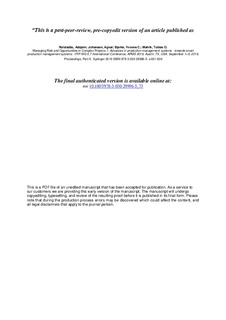| dc.contributor.author | Rolstadås, Asbjørn | |
| dc.contributor.author | Johansen, Agnar | |
| dc.contributor.author | Bjerke, Yvonne C. | |
| dc.contributor.author | Malvik, Tobias O. | |
| dc.date.accessioned | 2019-11-21T10:12:53Z | |
| dc.date.available | 2019-11-21T10:12:53Z | |
| dc.date.created | 2019-09-03T02:54:33Z | |
| dc.date.issued | 2019 | |
| dc.identifier.citation | Advances in production management systems : towards smart production management systems : IFIP WG 5.7 International Conference, APMS 2019, Austin, TX, USA, September 1–5, 2019, Proceedings, Part II. 631-639. | nb_NO |
| dc.identifier.isbn | 978-3-030-29999-6 | |
| dc.identifier.uri | http://hdl.handle.net/11250/2629693 | |
| dc.description | This is a PDF file of an unedited manuscript that has been accepted for publication. As a service to our customers we are providing this early version of the manuscript. The manuscript will undergo copyediting, typesetting, and review of the resulting proof before it is published in its final form. Please note that during the production process errors may be discovered which could affect the content, and all legal disclaimers that apply to the journal pertain. | nb_NO |
| dc.description.abstract | Projects is the preferred model for one-of-a-kind production. Projects may be difficult to manage due to complexity and many involved stakeholders. Stakeholders are a major source of uncertainty. Uncertainty may be both positive and create opportunities and negative giving risks. Risks and opportunities are either operational, strategic or contextual. The traditional approach to managing risk comprise dentification and analysis of risks as well as response planning and control. There is a need for a shift in mindset for managing risks. Rather than regarding risks as “evil”, they should be managed because uncertainties also create opportunities. The Bermuda Risk Triangle is the intersection between operational, strategic and contextual risks. Project risk navigation is about how project leaders can navigate in this triangle to reach their objectives. Opportunities are often more or less neglected in projects. At the most, just a few are identified.
A framework for managing opportunities is suggested. It builds on the project control variables: time, cost and scope of work. It contains a classification of eight opportunity types. Using this classification in dedicated workshops has shown to produce far more opportunities than usual. The framework is verified in a case study. The case is the construction of the new National Museum in Oslo, Norway. Through the framework a total of 246 opportunities have been identified representing an estimated cost reduction of about 64.2 million USD. | nb_NO |
| dc.language.iso | eng | nb_NO |
| dc.relation.ispartof | Advances in Production Management Systems - Production Management for the Factory of the Future | |
| dc.title | Managing Risk and Opportunities in Complex Projects | nb_NO |
| dc.type | Chapter | nb_NO |
| dc.description.version | acceptedVersion | nb_NO |
| dc.source.pagenumber | 631-639 | nb_NO |
| dc.identifier.cristin | 1720790 | |
| cristin.unitcode | 222,0,0,0 | |
| cristin.unitname | Universitetet i Sørøst-Norge | |
| cristin.ispublished | true | |
| cristin.fulltext | original | |
| cristin.fulltext | postprint | |
| cristin.qualitycode | 1 | |
